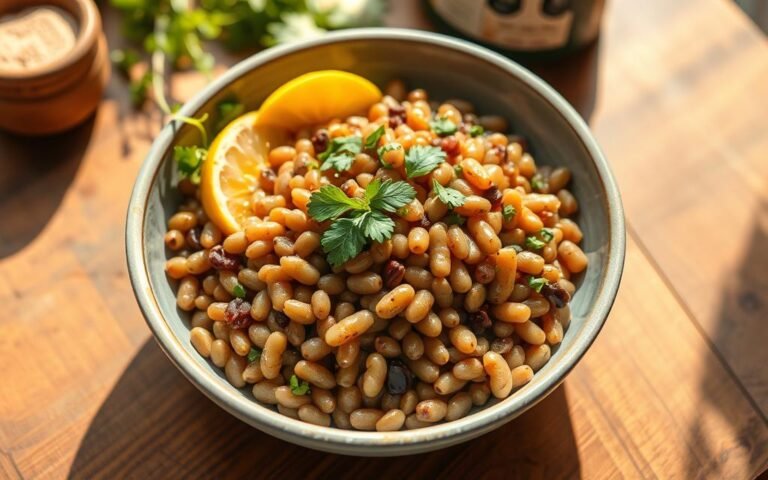Lentils are a type of legume rich in prebiotic fiber, which plays a crucial role in maintaining a healthy digestive system. Consuming lentils can have a positive impact on gut health by promoting the growth of beneficial gut bacteria.
The prebiotic fiber in lentils acts as a food source for the good bacteria in the gut, supporting a balanced gut microbiome. This balance is essential for overall well-being, influencing not just digestion but also the immune system.
Key Takeaways
- Lentils are rich in prebiotic fiber.
- Prebiotic fiber promotes the growth of beneficial gut bacteria.
- A balanced gut microbiome is essential for overall health.
- Consuming lentils can positively impact gut health.
- Lentils support digestive wellness.
The Nutritional Profile of Lentils
The nutritional profile of lentils is impressive, with a blend of protein, fiber, and essential vitamins and minerals. Lentils are a versatile legume that can be incorporated into various dishes, providing a nutritional boost.
Macro and Micronutrients in Lentils
Lentils are rich in both macronutrients and micronutrients, making them an excellent addition to a healthy diet.
Protein and Essential Amino Acids
Lentils are an excellent source of protein, containing approximately 9 grams of protein per 100 grams. They provide essential amino acids, although they are low in methionine and cysteine. Combining lentils with grains can provide a complete protein profile.
Vitamins and Minerals
Lentils are rich in various vitamins and minerals, including folate, iron, zinc, and potassium. Folate is crucial for cell division and the formation of red blood cells, while iron is essential for oxygen transport in the body.
Fiber Content in Different Lentil Varieties
The fiber content in lentils varies among different varieties. Generally, lentils are high in dietary fiber, with red lentils containing around 7.9 grams of fiber per 100 grams, while green lentils contain about 10.7 grams per 100 grams. This fiber is crucial for digestive health and supporting the gut microbiome.
- Lentils are rich in protein and fiber.
- They provide essential vitamins and minerals like folate and iron.
- The fiber content varies among different lentil varieties.
Understanding Gut Health and Its Importance
Maintaining a healthy gut is crucial for overall well-being, influencing everything from digestion to mental health. A healthy gut microbiome is essential for proper digestion, immune function, and even mental health stability.
The Gut Microbiome Explained
The gut microbiome refers to the trillions of microorganisms living in the gastrointestinal tract. These microorganisms play a vital role in our health.
Diversity of Gut Bacteria
A diverse gut microbiota is crucial for maintaining health. It includes various species of bacteria, each with unique functions.
Functions of the Microbiome
The gut microbiome is involved in several key functions, including the breakdown of complex foods, production of certain vitamins, and regulation of the immune system.
Signs of a Healthy vs. Unhealthy Gut
A healthy gut is characterized by a balanced gut microbiota, regular bowel movements, and the absence of digestive issues. In contrast, an unhealthy gut may exhibit symptoms like bloating, abdominal pain, and irregular bowel movements.
| Characteristics | Healthy Gut | Unhealthy Gut |
|---|---|---|
| Gut Microbiota | Diverse and balanced | Imbalanced, with potential overgrowth of harmful bacteria |
| Bowel Movements | Regular and comfortable | Irregular, with potential for constipation or diarrhea |
| Digestive Issues | Minimal to none | Bloating, abdominal pain, gas |
What Are Prebiotics and Why Do They Matter?
Understanding prebiotics is essential for appreciating how lentils support gut health and overall well-being. Prebiotics are non-digestible fibers that serve as food for beneficial bacteria in the gut, promoting a healthy gut microbiome.
Defining Prebiotic Fiber
Prebiotic fiber is a type of dietary fiber that is not broken down by the body but is instead fermented by bacteria in the gut. This process helps to nourish beneficial bacteria, supporting a balanced gut microbiome. Prebiotic fiber is found in various foods, with lentils being one of the richest sources.
Prebiotics vs. Probiotics: Understanding the Difference
While both prebiotics and probiotics are important for gut health, they serve different functions. Probiotics are live bacteria that are introduced into the gut to enhance its microbial balance. In contrast, prebiotics provide the necessary nutrients for these beneficial bacteria to thrive. Together, they work synergistically to support digestive health.
How Prebiotics Nourish Beneficial Gut Bacteria
Prebiotics nourish beneficial gut bacteria by providing them with the necessary fiber to ferment. This fermentation process produces short-chain fatty acids, which are used by the cells lining the colon, providing energy and supporting the health of the gut lining. By fostering a healthy gut microbiome, prebiotics play a crucial role in overall digestive health and well-being.
How Lentils Support Gut Health
Prebiotic fibers in lentils play a crucial role in maintaining a healthy gut microbiome. Lentils are rich in various types of prebiotic fibers, which are not fully digested in the small intestine but are fermented by beneficial bacteria in the colon.
Types of Prebiotic Fiber Found in Lentils
Lentils contain a diverse range of prebiotic fibers, including resistant starch and oligosaccharides. These fibers are crucial for the nourishment of beneficial gut bacteria.
Resistant Starch Content
Resistant starch is a type of prebiotic fiber that resists digestion in the small intestine and is fermented in the colon. It acts as a food source for beneficial bacteria, promoting their growth and activity.
Oligosaccharides and Other Fibers
Oligosaccharides, such as raffinose, are another type of prebiotic fiber found in lentils. These fibers are fermented by gut bacteria, producing short-chain fatty acids that provide energy to the cells lining the colon and help maintain a healthy gut environment.
The Fermentation Process in the Gut
The fermentation of prebiotic fibers by gut bacteria is a critical process that supports gut health. During fermentation, beneficial bacteria produce short-chain fatty acids, which have anti-inflammatory properties and contribute to the maintenance of the gut barrier.
| Type of Fiber | Function | Benefit to Gut Health |
|---|---|---|
| Resistant Starch | Resists digestion, fermented in colon | Promotes growth of beneficial bacteria |
| Oligosaccharides | Fermented by gut bacteria | Produces short-chain fatty acids, supports gut barrier |
As Dr. Jane Smith, a renowned nutritionist, notes, “The prebiotic fibers in lentils are a key factor in their ability to support gut health and promote a balanced gut microbiome.”

Research-Backed Benefits of Lentils for Digestive Health
Lentils, rich in prebiotic fiber, have been shown to support gut health through their beneficial effects on gut microbiota. The consumption of lentils can lead to a more balanced gut microbiome, which is crucial for overall digestive health.
Scientific Studies on Lentils and Gut Microbiota
Several studies have investigated the impact of lentils on gut microbiota. Research has shown that lentil consumption can increase the abundance of beneficial bacteria in the gut, enhancing the gut barrier function and reducing inflammation.
Short-Chain Fatty Acids Production from Lentil Consumption
The prebiotic fiber in lentils is fermented by gut bacteria to produce short-chain fatty acids (SCFAs), which play a crucial role in maintaining colon health and reducing inflammation.
Butyrate and Colon Health
Butyrate, a type of SCFA, is particularly beneficial for colon health. It serves as the primary energy source for colonocytes and has anti-inflammatory properties, helping to maintain a healthy colon lining.
Anti-Inflammatory Effects
The SCFAs produced from lentil consumption also have anti-inflammatory effects, which can help reduce the risk of chronic diseases such as inflammatory bowel disease (IBD) and colon cancer.
| Benefit | Description |
|---|---|
| Increased Beneficial Bacteria | Lentil consumption promotes the growth of beneficial gut bacteria. |
| Enhanced Gut Barrier Function | A stronger gut barrier reduces the risk of inflammation and infection. |
| Production of SCFAs | Lentil fiber is fermented to produce SCFAs, which are beneficial for colon health. |
Different Types of Lentils and Their Gut Health Benefits
The diverse world of lentils includes several types, such as red, green, brown, and black lentils, which offer distinct advantages for digestive health. Each type of lentil has its unique nutritional profile, contributing to the overall gut health benefits associated with lentil consumption.
Red Lentils: Nutritional Profile and Digestibility
Red lentils are known for their high prebiotic fiber content and are easily digestible, making them an excellent choice for those looking to support their gut health. They are rich in nutrients and have a softer texture compared to other varieties, which makes them cook faster and easier to digest.
Green Lentils: Fiber Content and Gut Benefits
Green lentils are another popular variety that is rich in prebiotic fiber, contributing to a healthy gut microbiome. They have a slightly firmer texture than red lentils and retain their shape well after cooking, making them versatile for various recipes.
Brown Lentils: Prebiotic Properties
Brown lentils are a staple in many cuisines and are valued for their prebiotic properties. They contain a significant amount of fiber, which helps in nourishing the beneficial bacteria in the gut, thus supporting a balanced gut microbiome.
Black Lentils: Antioxidants and Gut Health
Black lentils, also known as beluga lentils, are not only rich in antioxidants but also contain a good amount of prebiotic fiber. The antioxidants in black lentils help in reducing oxidative stress, while the fiber content supports the growth of beneficial gut bacteria, thereby enhancing overall gut health.
Lentils vs. Other Legumes for Gut Health
Lentils are a popular choice for those seeking to improve their gut health, but how do they compare to other legumes? Legumes are a diverse group of plants that are known for their nutritional benefits, including their ability to support gut health through their prebiotic fiber content.
Comparing Fiber Content and Prebiotic Potential
Different legumes vary in their fiber content and prebiotic potential. For instance, lentils are known for their high fiber content, with a single cup of cooked lentils providing about 16 grams of fiber. Other legumes like chickpeas, black beans, and kidney beans also offer significant amounts of fiber, ranging from 9 to 15 grams per cup cooked. The prebiotic potential of these legumes is linked to their ability to nourish beneficial gut bacteria.
- Lentils: High in fiber, particularly soluble fiber, which is fermented by gut bacteria.
- Chickpeas: Rich in raffinose, a complex sugar that acts as a prebiotic.
- Black beans: Contain a mix of soluble and insoluble fiber, supporting a diverse gut microbiome.
Digestibility Factors Among Different Legumes
Digestibility is another important factor when comparing legumes for gut health. Lentils are generally considered easy to digest, especially when compared to larger, harder legumes. Soaking and cooking can improve the digestibility of most legumes.
Key digestibility factors include:
- The type of fiber: Soluble fiber is generally more easily fermented by gut bacteria.
- Preparation methods: Soaking, cooking, and sprouting can enhance digestibility.
- Individual tolerance: Some people may find certain legumes easier to digest than others.
How to Prepare Lentils for Maximum Gut Health Benefits
Unlocking the full gut health potential of lentils requires understanding the best preparation techniques. Proper preparation can enhance the bioavailability of nutrients and prebiotic fiber, making lentils a more effective tool for supporting digestive health.
Soaking and Sprouting Methods
Soaking lentils can help reduce phytic acid, a compound that can inhibit nutrient absorption. Sprouting, which involves allowing the lentils to germinate, can further enhance their nutritional profile by increasing enzyme activity and reducing anti-nutrients. Sprouting lentils for 2-3 days can significantly boost their nutritional value.

Cooking Techniques That Preserve Prebiotic Content
Cooking lentils can be done in various ways, but some methods are better than others for preserving prebiotic fiber. Steaming or lightly boiling lentils can help retain more of their prebiotic content compared to overcooking or using high heat for extended periods.
| Cooking Method | Prebiotic Retention |
|---|---|
| Steaming | High |
| Boiling | Medium |
| Pressure Cooking | Low |
Fermentation of Lentils for Enhanced Benefits
Fermenting lentils can enhance their gut health benefits by increasing the bioavailability of nutrients and creating beneficial probiotics. Fermentation involves allowing the natural bacteria on the lentils to ferment, creating lactic acid and preserving the lentils. This process can make lentils easier to digest and more nutritious.
By incorporating these preparation methods into your diet, you can maximize the gut health benefits of lentils and support a healthy digestive system.
Incorporating Lentils Into Your Daily Diet
Making lentils a staple in your diet can have profound effects on your gut microbiome. Lentils are rich in prebiotic fiber, which nourishes beneficial gut bacteria, supporting overall digestive health. Incorporating these legumes into your daily meals can be both easy and delicious.
Easy Lentil Recipes for Gut Health
Lentils can be prepared in a variety of ways to support gut health. Here are some ideas:
- Add lentils to soups and stews for an extra boost of prebiotic fiber.
- Use lentils as a base for salads, combining them with vegetables and lean proteins.
- Make lentil-based curries, seasoned with spices that aid digestion.
Australian-Inspired Lentil Dishes
Australia’s multicultural cuisine offers a wide range of lentil-based dishes. Try making a lentil and vegetable stir-fry inspired by Asian cuisine, or a hearty lentil soup with a Mediterranean twist.
Quick Weekday Lentil Meals
For busy weekdays, consider quick and easy lentil meals such as lentil salads or lentil wraps. These can be prepared in advance and are perfect for a nutritious lunch on the go.
Recommended Serving Sizes for Optimal Benefits
To reap the benefits of lentils for gut health, it’s essential to consume them in appropriate serving sizes. Aim for about 1 cup of cooked lentils per serving, incorporating them into your meals 2-3 times a week. This can help support a healthy gut microbiome and overall digestive well-being.
Potential Digestive Side Effects and How to Minimize Them
While lentils are generally considered a gut-friendly food, some individuals may experience digestive side effects when introducing them into their diet. This is often due to their high fiber and prebiotic content, which can be beneficial for gut health but may also cause discomfort in some people.
To manage these side effects, it’s essential to understand the common issues that arise and how to mitigate them. Increasing fiber intake gradually can help the gut microbiome adjust to the new fiber sources, reducing the likelihood of adverse effects.
Common Digestive Issues When Introducing Lentils
Some of the common digestive issues people face when introducing lentils into their diet include bloating, gas, and abdominal discomfort. These symptoms are typically a result of the gut microbiome fermenting the prebiotic fibers in lentils, producing short-chain fatty acids and gas as byproducts.
As Dr. Megan Rossi, a renowned gut health expert, suggests, “Starting with small portions and gradually increasing the amount can help minimize digestive discomfort.” It’s also beneficial to soak and rinse lentils before cooking to reduce some of the anti-nutrients that can cause digestive issues.
“A gradual introduction to lentils, combined with proper preparation methods, can significantly reduce the risk of digestive side effects.”
By being mindful of these factors and adjusting consumption accordingly, individuals can enjoy the nutritional benefits of lentils while minimizing potential digestive discomfort.
Lentils and Specific Gut Conditions
The prebiotic fiber in lentils plays a crucial role in managing various gastrointestinal disorders. Lentils are rich in nutrients and have been found to offer numerous benefits for individuals suffering from specific gut conditions.
Lentils for Irritable Bowel Syndrome Management
Lentils can be beneficial for individuals with Irritable Bowel Syndrome (IBS). The prebiotic fiber in lentils helps nourish beneficial gut bacteria, which can lead to improved gut health and reduced symptoms of IBS. Incorporating lentils into the diet may help manage IBS symptoms such as bloating and abdominal pain.
Benefits for Inflammatory Bowel Disease
For individuals with Inflammatory Bowel Disease (IBD), lentils can provide significant benefits. The anti-inflammatory properties of lentils, combined with their prebiotic fiber, can help reduce inflammation in the gut and promote healing. This can lead to improved overall gut health and a reduction in IBD symptoms.
Lentils and Diverticular Disease
Lentils are also beneficial for individuals with diverticular disease. The high fiber content in lentils helps promote regular bowel movements and prevent constipation, which is a key factor in managing diverticular disease. Additionally, the prebiotic fiber in lentils supports the growth of beneficial bacteria, further contributing to gut health.
In conclusion, lentils offer a range of benefits for individuals with specific gut conditions, including IBS, IBD, and diverticular disease. By incorporating lentils into their diet, individuals can potentially alleviate symptoms and improve their overall gut health.
The Role of Lentils in Australian Dietary Guidelines
Australian dietary guidelines emphasize the consumption of various legumes, with lentils being a key component. Lentils are recognized for their nutritional benefits, including their role in supporting gut health through prebiotic fiber.
Current Recommendations for Legume Consumption
The Australian Dietary Guidelines recommend consuming a variety of legumes, including lentils, as part of a balanced diet. Specifically, they suggest adults aim for 75g to 100g of legumes per day. Lentils are highlighted for their high fiber and protein content, making them an excellent choice for those looking to improve their digestive health.
Australian Consumption Patterns and Health Outcomes
Despite the recommendations, the actual consumption of lentils and other legumes in Australia varies. Studies have shown that increased consumption of legumes is associated with improved health outcomes, including better gut health and reduced risk of chronic diseases.
Regional Differences in Lentil Consumption
There are regional differences in lentil consumption across Australia, influenced by cultural and socioeconomic factors. Some regions show higher consumption rates due to cultural dietary practices that emphasize legumes.
Public Health Initiatives Promoting Legumes
Public health initiatives in Australia have been promoting the consumption of legumes, including lentils, through various programs and campaigns. These initiatives aim to educate the public about the health benefits of legumes and provide practical tips on incorporating them into daily meals.
By understanding the role of lentils in Australian dietary guidelines and promoting their consumption, Australians can make informed choices about their diet and improve their overall health and wellbeing.
Combining Lentils with Other Gut-Friendly Foods
Combining lentils with other prebiotic-rich foods creates a synergistic effect that supports a healthy gut microbiome. This synergy can enhance the overall benefits of lentils for gut health, making them an even more valuable part of a balanced diet.
Synergistic Food Combinations for Gut Health
To maximize the benefits of lentils, it’s helpful to pair them with other foods that support gut health. Two effective strategies involve combining lentils with fermented foods and prebiotic-rich foods.
Lentils with Fermented Foods
Fermented foods like yogurt, sauerkraut, and kimchi contain live cultures that can help populate the gut with beneficial bacteria. When consumed alongside lentils, these foods can enhance the prebiotic effect, supporting a robust gut microbiome.
Prebiotic-Rich Food Pairings
In addition to lentils, other prebiotic-rich foods like asparagus, bananas, and onions can further nourish beneficial gut bacteria. Combining these foods with lentils can create a diverse and resilient gut ecosystem.
Creating Balanced Gut-Supporting Meals
To create balanced meals that support gut health, consider combining lentils with a variety of vegetables, whole grains, and lean proteins. A sample meal might include lentil soup with a side of steamed asparagus and whole-grain bread.
| Food | Prebiotic Benefit | Gut Health Support |
|---|---|---|
| Lentils | High in prebiotic fiber | Supports beneficial bacteria |
| Asparagus | Rich in inulin | Nourishes gut microbiome |
| Onions | Contains fructooligosaccharides | Promotes gut health |
By thoughtfully combining lentils with other gut-friendly foods, individuals can create a diet that is highly supportive of overall gut health and well-being.
Sustainable Aspects of Lentil Production and Gut Health
The production of lentils not only supports gut health through its prebiotic fiber but also contributes to a more sustainable food system. Lentils are a crop that requires less water compared to other legumes and crops, making them a more sustainable option for food production.
Environmental Benefits of Lentil Farming in Australia
Lentil farming in Australia is associated with several environmental benefits. It is known to improve soil health through nitrogen fixation, reducing the need for synthetic fertilizers. According to a study published in Frontiers in Sustainable Food Systems, such practices can enhance soil biodiversity and structure, contributing to a more resilient agricultural ecosystem.
Connection Between Sustainable Foods and Gut Microbiome
There is a growing body of evidence suggesting a connection between the consumption of sustainable foods and the health of the gut microbiome. Foods like lentils, which are produced using sustainable agricultural practices, can have a positive impact on gut health. The prebiotic fiber in lentils nourishes beneficial gut bacteria, supporting a balanced gut microbiome.
By choosing sustainable food options like lentils, consumers can contribute to a healthier environment while also supporting their own health, particularly gut health.
Common Myths and Misconceptions About Lentils and Digestion
Despite their nutritional benefits, lentils are often misunderstood when it comes to digestive health. Many people believe that lentils are difficult to digest or cause significant discomfort. However, the truth is that lentils can be a valuable addition to a gut-friendly diet.
Addressing Anti-Nutrient Concerns
One common concern is that lentils contain anti-nutrients, which can interfere with nutrient absorption. While it’s true that lentils contain phytates and other anti-nutrients, proper preparation methods like soaking and sprouting can significantly reduce these compounds. For more information on preparing lentils, you can visit our FAQ page.
Debunking Digestibility Myths
Another myth is that lentils are inherently hard to digest. In reality, lentils are relatively easy on the digestive system, especially when cooked properly. The fiber in lentils acts as a prebiotic, feeding the good bacteria in the gut, which can lead to a healthier gut microbiome. By incorporating lentils into your diet, you can support your overall digestive health.
Conclusion: Making Lentils a Gut Health Staple
Incorporating lentils into your diet can have significant benefits for gut health. As a rich source of prebiotic fiber, lentils support the growth of beneficial gut bacteria, promoting a healthy gut microbiome.
The various types of lentils, including red, green, brown, and black, offer a range of nutritional profiles and gut health benefits. By understanding how to prepare and incorporate lentils into your daily meals, you can maximize their digestive health benefits.
Australian dietary guidelines recommend increasing legume consumption, and lentils are an excellent choice. By making lentils a staple in your diet, you can support your overall gut health and well-being, while also contributing to a more sustainable food system.
With their high prebiotic content and versatility in cooking, lentils are an ideal food for supporting digestive health with legumes. By incorporating lentils into your diet, you can take a proactive approach to maintaining a healthy gut and overall well-being.





